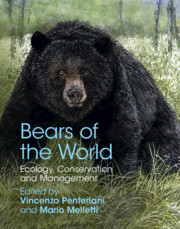Book contents
- Bears of the World
- Bears of the World
- Copyright page
- Dedication
- Frontispiece
- Contents
- Contributors
- Foreword
- Acknowledgments
- Introduction
- Part I Systematics, Ecology, and Behavior
- Part II Species Accounts
- Part III Human–Bear Coexistence
- Part IV Conservation and ManagementConservation and Management
- Chapter 20 Conservation and Management of Bears
- Chapter 21 How Is Climate Change Affecting Polar Bears and Giant Pandas?
- Chapter 22 Managing for Interpopulation Connectivity of the World’s Bear Species
- Chapter 23 Ex Situ Conservation of Bears: Roles, Status, and Management
- Chapter 24 The Challenge of Brown Bear Management in Hokkaido, Japan
- Chapter 25 Potential Ecological Corridors for Remnant Asiatic Black Bear Populations and its Subpopulations Linked to Management Units in Japan
- Chapter 26 Captive Bears in Asia: Implications for Animal Welfare and Conservation
- Chapter 27 Human Dimensions of Asiatic Black Bear Conflicts and Management in Japan
- Chapter 28 Ecological and Social Dimensions of Sloth Bear Conservation in Sri Lanka
- Index
- Miscellaneous Endmatter
- Plate Section (PDF Only)
- References
Chapter 21 - How Is Climate Change Affecting Polar Bears and Giant Pandas?
from Part IV - Conservation and ManagementConservation and Management
Published online by Cambridge University Press: 16 November 2020
- Bears of the World
- Bears of the World
- Copyright page
- Dedication
- Frontispiece
- Contents
- Contributors
- Foreword
- Acknowledgments
- Introduction
- Part I Systematics, Ecology, and Behavior
- Part II Species Accounts
- Part III Human–Bear Coexistence
- Part IV Conservation and ManagementConservation and Management
- Chapter 20 Conservation and Management of Bears
- Chapter 21 How Is Climate Change Affecting Polar Bears and Giant Pandas?
- Chapter 22 Managing for Interpopulation Connectivity of the World’s Bear Species
- Chapter 23 Ex Situ Conservation of Bears: Roles, Status, and Management
- Chapter 24 The Challenge of Brown Bear Management in Hokkaido, Japan
- Chapter 25 Potential Ecological Corridors for Remnant Asiatic Black Bear Populations and its Subpopulations Linked to Management Units in Japan
- Chapter 26 Captive Bears in Asia: Implications for Animal Welfare and Conservation
- Chapter 27 Human Dimensions of Asiatic Black Bear Conflicts and Management in Japan
- Chapter 28 Ecological and Social Dimensions of Sloth Bear Conservation in Sri Lanka
- Index
- Miscellaneous Endmatter
- Plate Section (PDF Only)
- References
Summary
Anthropogenic greenhouse gas emissions are the primary cause of climate change and an estimated increase of 3.7 to 4.8 °C is predicted by the year 2100 if emissions continue at current levels. Polar bears (Ursus maritimus) and giant pandas (Ailuropoda melanoleuca) provide an interesting comparison study of the impact of climate change on bear species. While polar bears and giant pandas are arguably the most distant of the bear species with regard to life histories and behavior, both are likely to be significantly impacted by the broad-scale changes to their environment that are predicted to result from climate change. Herein, we review the conservation status of both species and their habitats, and present current and predicted evidence of the impacts of a changing climate on polar bear and giant panda survival.
- Type
- Chapter
- Information
- Bears of the WorldEcology, Conservation and Management, pp. 303 - 316Publisher: Cambridge University PressPrint publication year: 2020

